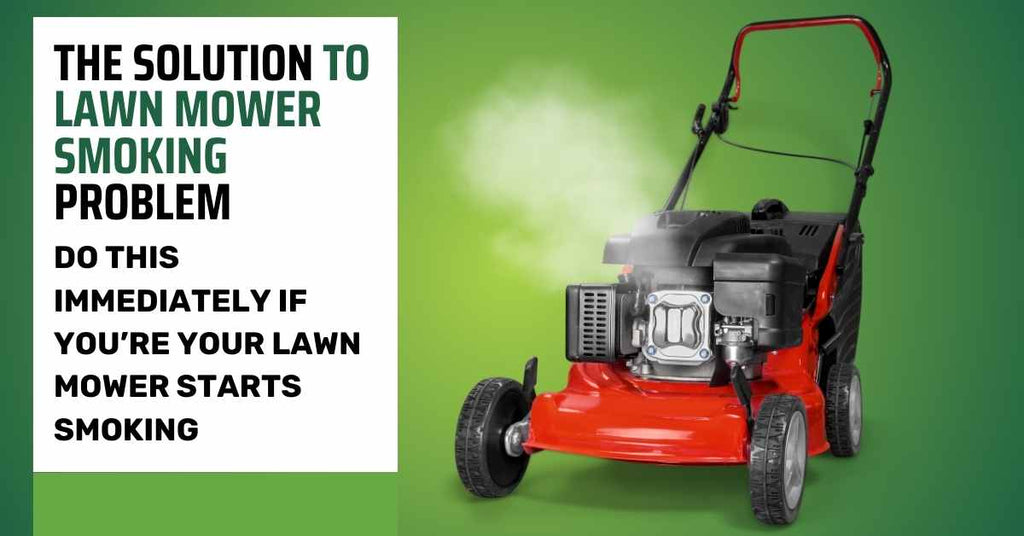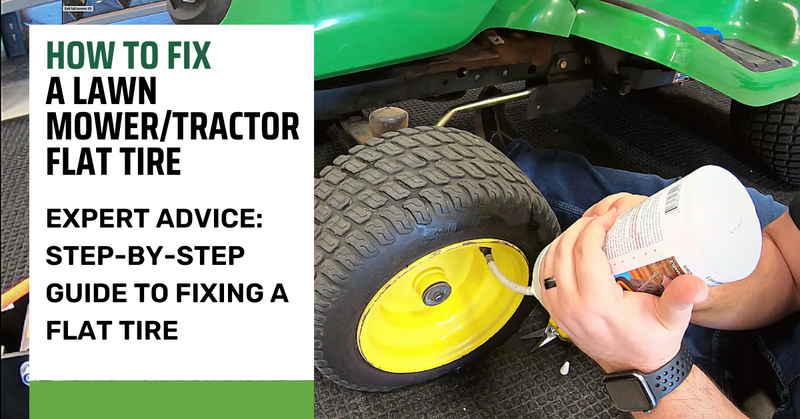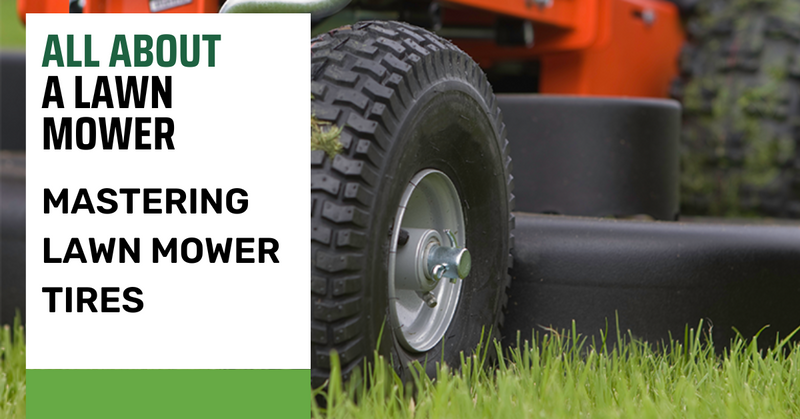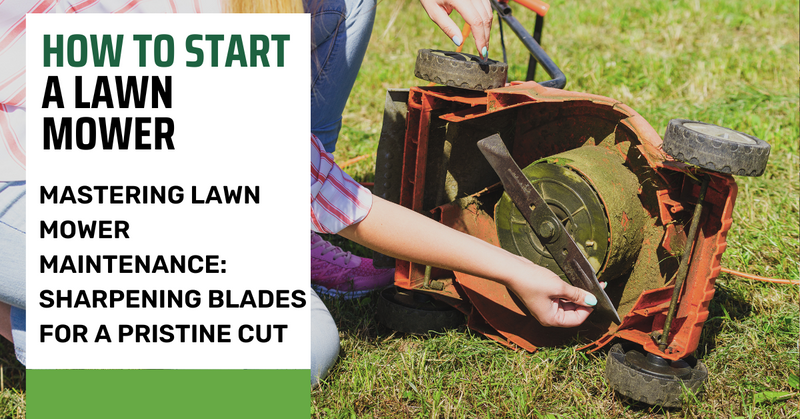

Why is my lawn mower smoking? This seemingly simple question can be a source of frustration for many lawn owners. Smoking mowers not only compromise the quality of lawn care but can also indicate underlying issues that need attention. In this comprehensive guide, we will explore the common causes of why your lawn mower is smoking, methods for diagnosis, and effective solutions to address and prevent this perplexing problem.
Table of Contents:[hide]
1. Common Causes of Lawn Mower Smoking

A. Engine Oil Issues
- Low Oil Levels
Low oil levels can lead to increased friction and heat in the engine, resulting in smoke emissions. Regularly check and maintain optimal oil levels to prevent this issue.
- Dirty or Old Oil
Using old or dirty oil can produce smoke due to impurities and reduced lubrication. Change the oil regularly following the manufacturer's recommendations for a cleaner engine and a smoke-free lawn.
B. Fuel System Problems
- Clogged Fuel System
A clogged fuel system restricts the flow of fuel, causing an uneven burn and smoke production. Inspect and clean fuel system components, including the carburetor, to ensure smooth operation.
- Issues with Carburetor
Problems with the carburetor, such as a stuck float or incorrect fuel-to-air ratio, can contribute to smoking. Regular maintenance and adjustment of the carburetor can resolve these issues.
C. Air Filter Troubles
- Clogged Air Filter
A clogged air filter impedes airflow, leading to a rich fuel mixture and smoke. Regularly inspect, clean, or replace the air filter to maintain proper combustion and reduce smoke emissions.
- Importance of Regular Air Filter Maintenance
Regular air filter maintenance is crucial for preventing smoking lawn mower issues. Clean or replace the air filter according to the manufacturer's recommendations to ensure optimal engine performance.
2. Diagnosing Lawn Mower Smoking

A. Visual Inspection
- Checking for Visible Issues
A visual inspection involves looking for visible signs of damage, leaks, or loose components. Identify and address any immediate issues that may contribute to smoking.
- Identifying Immediate Concerns
Identifying immediate concerns during the visual inspection allows for quick fixes. Addressing visible issues promptly can prevent further damage and reduce smoke emissions.
B. Color and Smell
- Understanding the Significance of Smoke Color
Different smoke colors indicate various issues. White smoke may suggest burning coolant, while black smoke indicates a rich fuel mixture. Understanding these colors aids in accurate diagnosis.
- Using Smell as a Diagnostic Tool
The smell of the smoke can provide additional clues. The aroma of burning oil or fuel points to specific problems, helping in the identification of the root cause.
C. Checking Spark Plugs
- Role of Spark Plugs in Smoking lawn mower Issues
Spark plugs play a crucial role in the combustion process. Faulty or fouled spark plugs can result in incomplete combustion and smoke emissions.
- Steps to Inspect, Clean, or Replace Spark Plugs
Regularly inspect, clean, or replace spark plugs based on their condition. Properly functioning spark plugs contribute to efficient combustion and reduce the likelihood of smoking.
D. Color and Smell Analysis
- Understanding the Significance of White Smoke Color
Different smoke colors indicate various issues. White smoke may suggest burning coolant, while black smoke indicates a rich fuel mixture. Understanding these colors aids in accurate diagnosis.
- Utilizing Smell as a Diagnostic Tool
The smell of the smoke can provide additional clues. The aroma of burning oil or fuel points to specific problems, aiding in the identification of the root cause.
3. lawn mower smoking white
Common Causes of White Smoke:
When your lawn mower emits white smoke, several factors may contribute to this perplexing issue.
Fuel-related Issues:
One of the common culprits behind white smoke is fuel-related problems. Contaminated or old fuel can lead to inefficient combustion, resulting in visible white smoke.
Oil Overfill:
Excessive oil in the engine can cause the oil to burn, producing white smoke. Checking and maintaining the proper oil levels is crucial for optimal lawn mower performance.
Coolant Leakage:
A leaking coolant system may allow coolant to enter the combustion chamber, manifesting as white smoke. Regularly inspect the coolant system to identify and address any leaks promptly.
Damaged Head Gasket:
A damaged head gasket can permit coolant to enter the engine, leading to white smoke. If all else fails, a thorough examination of the head gasket may be necessary.
4. Addressing and Preventing Smoking
A. Immediate Solutions
- Quick Fixes for Visible Issues
Immediate solutions involve addressing visible issues found during the inspection. Tightening loose components or fixing leaks can provide quick relief from smoking.
- Tips for Emergency Situations
In emergency situations, where smoke is excessive, consider stopping the mower immediately. Assess the situation, and if necessary, seek professional assistance to prevent further damage.
B. Regular Maintenance
- Importance of Scheduled Oil Changes
Scheduled oil changes are fundamental to maintaining a healthy engine. Adhering to a routine for oil changes ensures proper lubrication and reduces the likelihood of smoking.
- Maintaining a Clean Fuel System
Regularly cleaning and maintaining the fuel system, including the carburetor, promotes consistent fuel delivery and combustion. A clean fuel system contributes to optimal engine performance.
C. Air Filter Replacement
- Choosing and Replacing Air Filters
Choosing high-quality air filters and replacing them at recommended intervals is essential. Premium air filters contribute to cleaner combustion and reduce smoke emissions.
- Impact of Air Filter Quality on Smoking
The quality of the air filter directly affects engine performance. Investing in a high-quality air filter can significantly reduce the chances of smoking and enhance overall mower efficiency.
5.wrapping up
In conclusion, understanding why your lawn mower is smoking is crucial for effective troubleshooting and maintenance. Regular inspections, timely repairs, and proactive measures can ensure a smoke-free lawn care experience. By addressing the root causes and implementing preventative measures, you'll not only enjoy a healthier lawn but also extend the lifespan of your mower.
this is the end of our insightful blog post! If you're ready to upgrade your lawn mower tires for peak performance, we invite you to browse our exclusive collection. Discover a wide range of high-quality, durable tires designed to enhance your lawn care experience.
Visit our Lawn Mower Tires Collection page here and choose the perfect set to ensure your mower glides smoothly through every mowing session.
FAQ's
Why is my lawn mower smoking after an oil change?
- Possible excess oil or low-quality oil causing combustion issues.
Can a dirty air filter cause smoking?
- Yes, a clogged air filter restricts airflow, leading to inefficient combustion and smoke.
How often should I inspect spark plugs?
- Recommended at least once a season or after 25 hours of use.
Are there eco-friendly alternatives to traditional oil?
- Yes, synthetic and bio-based oils are environmentally friendly options.
Can using premium fuel prevent smoking?
- Yes, premium fuel can contribute to reducing smoking issues.
What role does the exhaust system play in smoking issues?
- Issues in the exhaust system can lead to improper combustion and increased smoke emissions.










